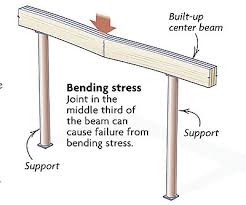Hello there,
For a long time, there has been something in my mind, which i cant seem to figure out how to deal with it.
By the way, this is totally a hypothetical question:
How do you calculate stiffness/Strength of 2 wooden beams bonded in the middle, but they are joint longitudinal, kind of like the scheme bellow. The joint is straight out FLAT, so no cuts or grooves. Also the beams are simply suported on both ends.
______________ _____________
......Beam nr, 1 ||Beam nr. 2
_____________||_____________
I wanna calculate deflection of the said beam. If you were to lineary press it in the middle (where the joint is)
If it was a normal beam i would take formula δmax = 5 q L4 / (384 E I), but here i dont know how to do it, if it is even possible.
Which parameters are important here? Obviously type of adhesive and the type of material used for the beams, and tensile strength, is there anything else that would need to be taken into the account?
Best regards,
For a long time, there has been something in my mind, which i cant seem to figure out how to deal with it.
By the way, this is totally a hypothetical question:
How do you calculate stiffness/Strength of 2 wooden beams bonded in the middle, but they are joint longitudinal, kind of like the scheme bellow. The joint is straight out FLAT, so no cuts or grooves. Also the beams are simply suported on both ends.
______________ _____________
......Beam nr, 1 ||Beam nr. 2
_____________||_____________
I wanna calculate deflection of the said beam. If you were to lineary press it in the middle (where the joint is)
If it was a normal beam i would take formula δmax = 5 q L4 / (384 E I), but here i dont know how to do it, if it is even possible.
Which parameters are important here? Obviously type of adhesive and the type of material used for the beams, and tensile strength, is there anything else that would need to be taken into the account?
Best regards,

